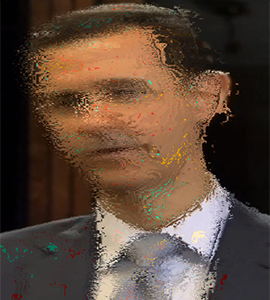Harvestworks Presents Prerogatives of Power: The Good, The Bad, and The Perturbed
This multi-screen installation is an homage to Antonio Muntadas’ 1987 installation The Board Room. Digital videos of political leaders from around the (Obama, Trump, Putin, Cameron, Xi Jinping, Assad, Merkel, Hassan Rouhani, Hollande, Kim Jung Un etc.) are displayed on multiple screens. The viewers motion perturbs the audio and digital video signal disrupting and interrupting the speech transforming messaging and political propaganda into visual and auditory artifacts with a separate aesthetic.
Exhibition dates: May 2nd to May 8th at Harvestworks
Reception for the Artist: Wednesday May 4, 2016 at 7 pm
Exhibition Time: noon – 5 pm FREE
Harvestworks 596 Broadway #602 New York NY 10012
Phone: 212-431-1130 Subway: F/M/D/B Broadway/Lafayette, R to Prince, #6 to Bleecker
The Prerogatives of Power: The Good, The Bad and The Perturbed is a multi-screen installation that displays full motion digital video portraits of political leaders from around the world (Obama, Putin, Trump, Cameron, Xi Jinping, Assad, Merkel, Hassan Rouhani, Hollande, Kim Jung Un etc.). An essential part of the total experience is the manipulated audio and video signal in real time. A camera based motion tracking system allows the movement of the gallery visitor to ‘preturb’ the digital video signal, scrambling the video and audio signal to create colorized effects and percussive distortions of the spoken word. For example, in an interview, the embattled president of Syria, Bashar al-Assad is quoted saying: “We do not use barrel bombs.” The motion tracking will trigger the breakup of Assad’s digital video image and the repetition of key words (e.g. b-b-b-barrel, b-b-b-bombs etc.). Wall mounted LCD displays have the visual impact as a gallery filled with large-scale paintings. In this instance the “painting” is full motion digital colorized video pixels. This dramatic format functions as a critique of the use and abuse of power. This multi-screen installation is an homage to Antonio Muntadas’ 1987 installation The Board Room. The viewer’s motion perturbs the audio and digital video signal disrupting and interrupting the speech transforming messaging and political propaganda into visual and auditory artifacts with a separate aesthetic.
BIOS
After finishing a Masters of Visual Studies degree at the Center for Advanced Visual Studies (CAVS) at MIT Greg Garvey worked at Parker Brothers and later Spinnaker Software developing mass market and educational games for personal computers and game consoles. In his own art practice Garvey saw the emerging possibilities of an art of interaction facilitated by computer control. In 1982 he exhibited at MIT “Labyrinthos” – a large-scale computer controlled ‘stochastic’ maze of locking and unlocking doors. Video cameras and monitors were placed within creating an irrational system of surveillance merging a viewer’s present moment of interaction with recordings of previous visitors.
Garvey has continued to design interactive computer based installations that have been exhibited in museums and galleries in the U.S., Canada, Europe and elsewhere in venues such as the Landesmuseum in Linz, Austria; the Victoria and Albert Museum in London or at Tech Fest in Delhi, India. His projects incorporate custom built interfaces that employ technologies such as capacitance touch sensors and camera base motion tracking.
Greg Garvey, MFA, MSVS, BS is the Chair of the Department of Visual and Performing Arts and also serves as Director of the Game Design and Development Program at Quinnipiac University. Previously at Quinnipiac University he was the Visiting Fellow in the Arts and also was an Associate Artist of the Digital Media Center for the Arts at Yale University. Prior to joining Quinnipiac University he was Chair of the Department of Design Art at Concordia University in Montréal and was a member of the Board of Directors of the Montreal Design Institute. From 1983-85 he was a Fellow at the Center for Advanced Visual Studies at MIT.
Thanks to Tommy Martinez for project assistance. Additional Max/Jitter Programming by Matthew Ostrowski.
“Greg Garvey’s special installation for Sleuthing the Mind is similarly dazzling: in its form as well as its content, Garvey’s piece manages to capture the absurdity and irrationality of a well-known, newsworthy moment– the 1991 Senate Judiciary Committee hearings on the nomination of Clarence Thomas to the U.S. Supreme Court– and deliver it in two parallel streams via a split-brain interface” –thebeautifulbrain.com
“Garvey enables us to experience the quandary of a divided mind. Although he was influenced by Michael Gazzaniga’s split-brain research (itself informed by Roger Sperry), Garvey has imaginatively aligned the cognitive difficulty with the political dissonance of the Anita Hill/ Clarence Thomas hearings.” – UnDo.Net
Despite the system’s manifest advantages – Garvey says it can conveniently provide the Church with a vast datastream for spotting sin trends among the flock – the ACM is unlikely to spring from gallery hall to hallowed hall anytime soon. – WIRED
http://mywebspace.quinnipiac.edu/garvey/GG/previousNew.html
http://thebeautifulbrain.com/2014/11/sleuthing-the-mind-exhibition-review/







